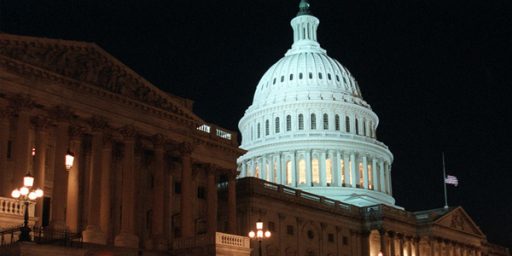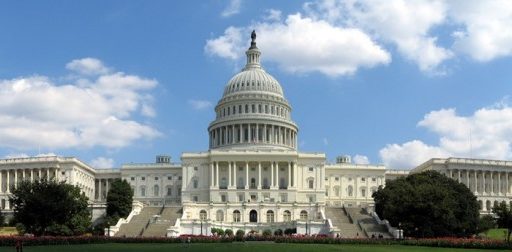Grover Norquist and Afghanistan
America's foremost tax foe has weighed in on the Afghanistan War debate.
When Steve Clemons invited me to “a salon discussion and dinner with Grover Norquist who will offer opening provocations in a discussion about America’s Afghanistan policy,” it took me about 3 seconds to RSVP. After all, the tax cut angle is one sorely missing from our discussion of that conflict!
I discuss the substance of the evening and provide some substantive analysis at New Atlanticist in a post titled “Afghanistan: Sparking a New Debate on an Old War.” A taste:
A new poll commissioned by the Clemons’ Afghanistan Study Group showing that, when informed that the war in Afghanistan was costing American taxpayers $117 billion a year, 71 percent of conservatives and 67 percent of Tea Partiers said they were “very worried” or “somewhat worried” about the financial burden of the war. In that context, 57 percent of conservatives and 55 percent of Tea Party supporters agreed, “The United States can dramatically lower the number of troops and money spent in Afghanistan without putting America at risk.”
Now, as I told Clemons and Norquist during the Q&A session, I think the poll is a publicity stunt of dubious probative value. (I may have used more colorful language.) The truth of the matter is that most Americans have only the vaguest notions of how much our government spends and therefore have no context whatsoever against which to judge numbers. ”$119 billion” is a scary number to bandy about but it’s a tiny fraction of a $3.69 trillion budget. One could imagine that, if people were told that the Department of Labor spends $117.5 billion a year, they’d wonder whether we couldn’t get by without that, too. Much less $915.5 billion for Health and Human Services. I’m guessing NAF won’t be polling on that, though.
The remainder of the lengthy essay explains why I think, in the end, that this gambit is unlikely to succeed, for reasons of both domestic and international politics.
What follows is not germane to that essay but perhaps useful for readers here, as insights into the strange world of public policymaking.
What’s particularly interesting to me is that an overwhelming consensus exists against the war, with two-thirds of Americans opposed. Even amongst Republicans, support is a tepid 52 percent. But those who want to stay in the fight are more committed than those who oppose it and the rhetoric of American politics makes fighting easier than quitting.
Nobody’s more plugged into elite conservative opinion than Grover Norquist and he says there’s an overwhelming desire amongst that group to get out. But — and this is my conjecture, not his assertion — the need to pander to the populist crowd keeps the political leaders going in the other direction.
Similarly, there’s pretty solid consensus among the think tankers and other policy wonks I know — ranging from the Nixon Center to Rand and CATO to the Brookings Institution and the New America’s Foundation — that we’re not going to achieve anything substantially more than we already have in Afghanistan. Yet the conversation remains driven by the likes of the American Enterprise Institute, even though a Democrat sits in the White House.
Lastly, this is the third or fourth of these dinners that I’ve attended and they’re really useful and enjoyable. Steve is an inveterate networker and he manages to bring together groups of people from different ideological perspectives and institutions that would otherwise never run into one another, much less spend an evening together. Norquist was engaging and the give-and-take with the audience was quite lively, while remaining friendly. It’s a shame these sort of sessions are so rare in policy circles.






Ooo, ooo, what was served for dinner? You are missing a chance to do the food blogging you used to do. More seriously, I think that you are pretty much right on here. Attempts to get out will bring out claims about cut and running. I can hear the stabbed in the back crowd now. Lindsey Graham is already pushing for permanent bases.
Steve
The $117 billion/year number is an underestimate — it likely doesn’t include things such as long-term care for wounded soldiers and other costs that won’t show up in this year’s balance sheet.
$117 billion is about 9% of the federal government’s discretionary budget and 3% of the total budget. That 3% number may be pretty small. But, in practical terms of cutting spending, 3% is a pretty large number in that there aren’t many (any?) opportunities to cut that much spending in one chunk without causing at least as much of a political firestorm as ending the war in Afghanistan would cause.
@ratufa:
I don’t disagree that it’s a sizable amount of money or that it excludes future costs. I’m just saying, to the average person, “$117 billion” simply has no meaning. It’s an overwhelmingly high number. But, then, most everything in the federal budget is.
>>>>Lastly, this is the third or fourth of these dinners that I’ve attended and they’re really useful and enjoyable. Steve is an inveterate networker and he manages to bring together groups of people from different ideological perspectives and institutions that would otherwise never run into one another, much less spend an evening together. Norquist was engaging and the give-and-take with the audience was quite lively, while remaining friendly. It’s a shame these sort of sessions are so rare in policy circles.<<<<
James, I have been naive at times (and admitted it) but my naivete pales in comparison to your own. Norquist???
He could not balance a budget with a trillion dollor surplus….
You are smarter than him.
Tom p; please use proper grammar: “you are smarter than he.”
117 billion here, 117 billion there, and pretty soon you’re talking about real money …
Also, that’s 117 billion per year. Few people think we’ll be leaving in the next few years. We’ve already been there for 9+. I’m not sure if we spent 117 billion each of those 9 years, but if so, we’re up to a trillion. (and as ratufa says, 117 billion is actually lower than the real cost).
I can’t swallow the argument that 117 billion is pocket change.
@TG:
It’s been difficult to get costs over the years, because most government figures include OEF/OIF as a package. But, certainly, Afghanistan has become radically more expensive the last two years as we’ve ramped up the operation.
And, again, I’m not arguing that $117 billion isn’t a hell of a lot of money. Rather, I argue that 1) the average Joe has no way to assess it beyond “holy shit that’s a lot of money!” and 2) the financial cost is the least of the reasons to wind down the mission.
“And, again, I’m not arguing that $117 billion isn’t a hell of a lot of money. Rather, I argue that 1) the average Joe has no way to assess it beyond “holy shit that’s a lot of money!” and 2) the financial cost is the least of the reasons to wind down the mission.”
I don’t know, if nothing else the average Joe can look at it and say that’s $350 from every man, woman and child in America … ie likely a thousand or more from his or her family.
And financial cost is part of what led to the fall of a lot of countries with large overseas commitments (or empires) over history … its not a trivial aspect of foreign intervention.